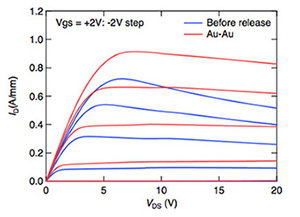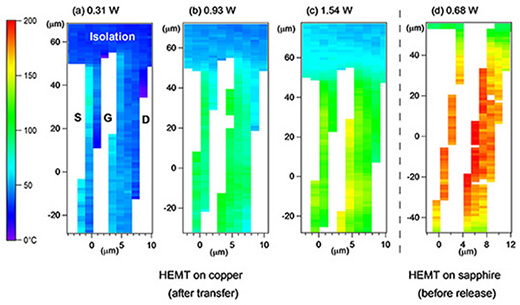Enhancement of Heat Dissipation in AlGaN/GaN High-electron-mobility Transistors Using Substrate-transfer Technique
III-nitride semiconductor materials can be applied for high-power devices by exploiting their high critical electric field. Under high current operation, however, power performance is limited due to the generation of Joule heat. We transferred AlGaN/GaN high electron mobility transistors (HEMTs) from a sapphire substrate to a copper plate using the hexagonal boron nitride epitaxial lift-off technique [1,2]. In this study, we transferred the HEMTs to a copper plate using Au-Au thermocompression bonding and found an increase in drain current (Id) and significant improvement of the heat dissipation [3].
Figure 1 shows an I-V characteristics of an AlGaN/GaN HEMT before release and after transfer. Before release, a large reduction in drain current Id vs drain bias (Vds) was observed in the saturation region. In contrast, for the HEMT after transfer, the negative slope of Id vs Vds decreased. In addition, we found a significant increase in maximum Id from 0.72 to 0.91
A/mm after transfer. The maximum transconductance also increased from 110 to 140 mS/mm. These indicate an increase in two-dimensional electron gas (2DEG) density. The increase in 2DEG density is likely caused by the reduction in compressive stress in the GaN layer, which is revealed from the E2 peak shift of –1.3 cm–1 in Raman spectroscopy measurement.
Figure 2 shows temperature maps of a HEMT transferred to a copper plate and another HEMT on a sapphire substrate. For the transferred HEMT, the temperature increased from 50 to 150°C with increasing power dissipation (P) from 0.3 to 1.5 W. For the HEMT on sapphire (before release), the temperature reached 240°C at P of 0.7 W. Our results indicate that the transfer technique using the h-BN release layer can enhance the heat dissipation and boost the power performance of GaN-based devises.
- [1] Y. Kobayashi et al., Nature 483, 223 (2012).
- [2] M. Hiroki et al., Appl. Phys. Lett. 105, 193509 (2014).
- [3] M. Hiroki et al., Jpn. J. Appl. Phys. 55, 05FH07 (2016).

|

|
| Fig. 1. I-V characteristics of AlGaN/GaN HEMT before release and after transfer. | Fig. 2. Temperature maps of a HEMT transferred to copper and another HEMT on sapphire. |